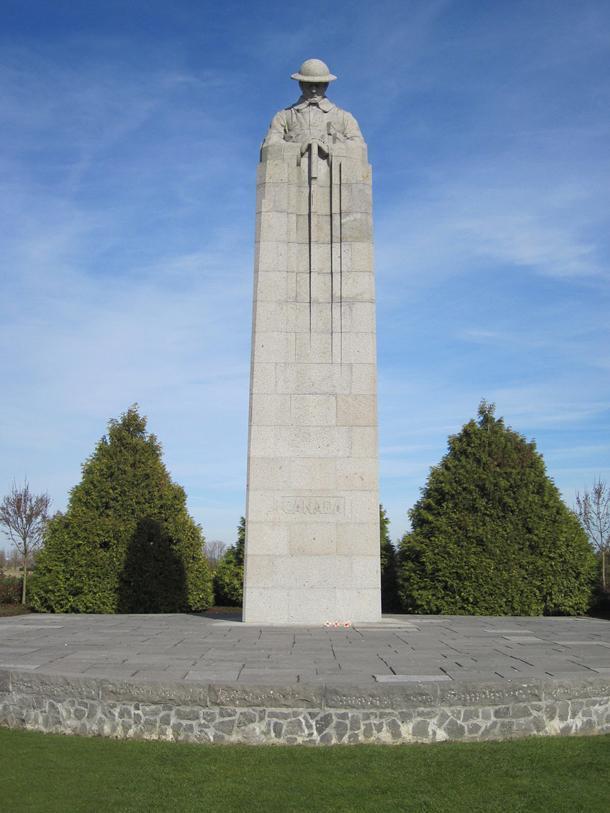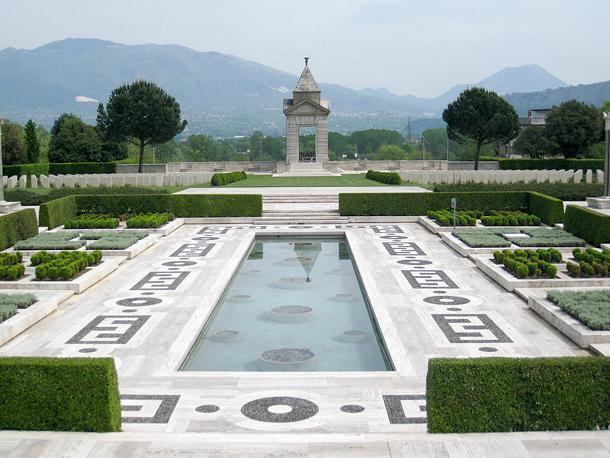
Canada, like Europe and the rest of the world, was deeply affected by the world wars. Place names like Vimy, Passchendaele, Ypres, and Dieppe, hold special significance for Canadians, as important moments in our history. In fact, modern Canadians owe a great deal to the men and women who sacrificed themselves in far flung locations around the world. Paraphrasing Pierre Berton, in “Marching As To War,” Canada gained her independence and identity — in effect, grew up — through the crucible of the First World War and the hard fought battles in the North Atlantic, Italian, and European campaigns of the Second World War. Canadian valour on the battlefields won us the right to self-government and a worldwide recognition of our nationhood, distinct from Britain.
Unlike typical Canadian self-effacement, when you speak about the wars, Canadians are extremely proud of their ancestor’s contributions to the victories. Almost every Canadian has a story to tell about one of their ancestors being involved in one or both of the wars. My grandfather’s uncle, Jack MacRae, is buried in Wancourt, France (WWI) and the grave of Alison’s great-uncle, Arthur Fair, is found just outside of Antwerp (WWII). Both came from rural, farming backgrounds and died serving their country in a foreign land. We never met them, but we are proud of their contribution.
Canadian War Memorials in Europe may seem like a sombre topic, but each of the memorials below tell a story of the courage, resolve, and sacrifices made by our soldiers. The performance of Canadian troops earned Canada great respect on the battlefield, from both friend and foe. Although this list is focused on Canadian memorials, these sites are worth visiting, no matter what flag you wear.
In a year fraught with controversy over immigrants, it is worth remarking on the origin of the names on some of these cenotaphs and gravestones; Scottish, Irish, Indian, Brazilian, Algerian, Egyptian, Jewish, Christian – men and women came from all over the globe to liberate Europe.
Canadian Memorials of the First World War (1914-1918)
Canadian troops were at the forefront of Allied attacks, in Flanders, from 1915 onwards. Canadians played a major role in developing tactics that would be used to push the Germans back, starting in 1917. During four years of battle, in the mud and horror of the trenches, the courage and sacrifice of Canadian soldiers would earn Canada the right to sign the peace treaty, the Treaty of Versailles.
The following are five memorials significant to the Canadian involvement in the First World War.
1. Vimy Memorial (France)
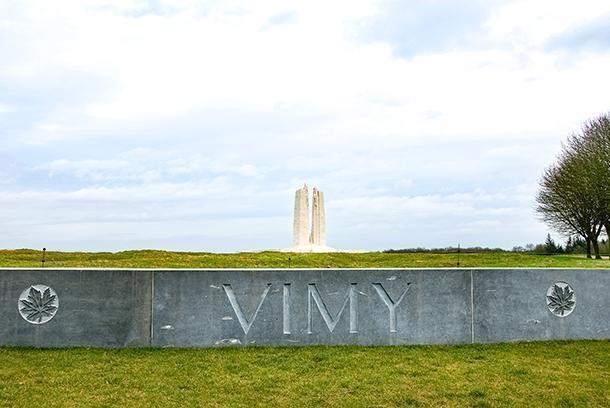
Vimy Ridge in France, should be on every Canadians list of war sites to visit
Arguably Canada’s most important monument in Europe, the Vimy Memorial stands atop a ridge, facing east, over the Douai plain. On April 9, 1917, after years of stalemate, the Canadians drove the Germans off the ridge, demonstrating how proper planning and preparation could overcome even the most difficult obstacles.
More than just a reminder of this battle, the memorial stands as a tribute to all the Canadians who fought for their country during the First World War. Built out of limestone, this towering monument features a cloaked sorrowful figure, representing Canada, carved from a single 30-tonne block of stone.
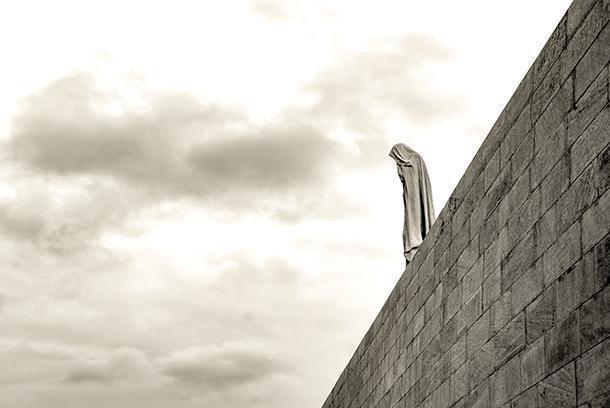
The sombre figure, at Vimy Ridge, represents a grieving Canada
Surrounding the monument, 11,285 names are carved into the walls, reminding visitors of those who fell but have never been found. Having been there numerous times, it is a humbling memorial to visit and should be a place of pilgrimage for every Canadian.
2. Beaumont-Hamel Newfoundland Memorial (France)
Since 1949, Newfoundland has been part of Canada. During the wars, Newfoundland fielded its own armed forces and these men and women fought bravely alongside other British and colonial troops. On July 1st, 1916 the Royal Newfoundland Regiment fought its first and costliest engagement, as part of the Battle of the Somme. Of almost 800 men, only 110 came out of the battle unscathed.
The Beaumont-Hamel Newfoundland Memorial is the largest of 5 memorials dedicated to Newfoundlanders, in Europe, and commemorates the lives of 814 Newfoundlanders who died during the First World War with no known grave. The memorial consists of a bronze statue of a caribou, the emblem of the Royal Newfoundland Regiment, standing on a mound, proudly overlooking the trenches, and facing the direction of the enemy.
3. St. Julien Memorial (Belgium)
In April, 1915, the allied forces had stopped the German advance, just outside Ypres (Ieper). On April 22, 1915, to break the stalemate and destroy the bulge around Ypres, the Germans unleashed their latest weapon: chlorine gas. The thick yellow-green gas drifted southwest, over the French front lines, asphyxiating many and confusing the rest. The French line was overrun and the Allied troops were threatened with being encircled.
Canadian soldiers, recently added into the bulge’s front line, were able to close the gap. For the next few days, the Canadians counterattacked, in the face of gas and violent artillery shelling, holding the line and preventing a German breakout. It is at St. Julien where Canadians first earned their reputation as a formidable fighting force.
The St. Julien Memorial commemorates this battle, with “The Brooding Soldier,” atop an 11m high pillar of granite. It is a sobering memorial, as the soldier holds his weapon in a reverse arms position, a sign of respect for those who fell.
4. Ypres (Belgium)
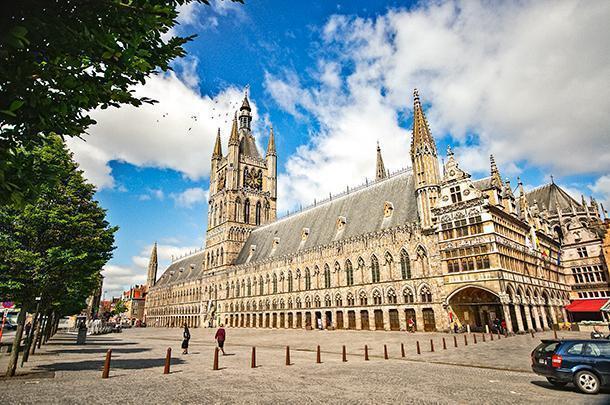
The In Flanders Fields Museum offers a personal look at the effects of WWI on this area of Belgium
Not a memorial per say, but any visit to the WWI battlefields must include a visit to the town of Ypres (Ieper). Despite being nearly erased from the map, the town held on and defied every German advance for four long years. Ypres became a symbol of the Allied resistance.
In the centre of the town is the In Flanders Fields Museum and it is an excellent place to start. The museum shows the human (or inhuman) side of the conflict and provides perspective on the situation in Flanders. Then take a walk up to Menin Gate to see the long list of names of men and women with no known grave. Finally, consider a battlefield tour starting from Ypres, to be able to understand just how desperate the situation was in this area.
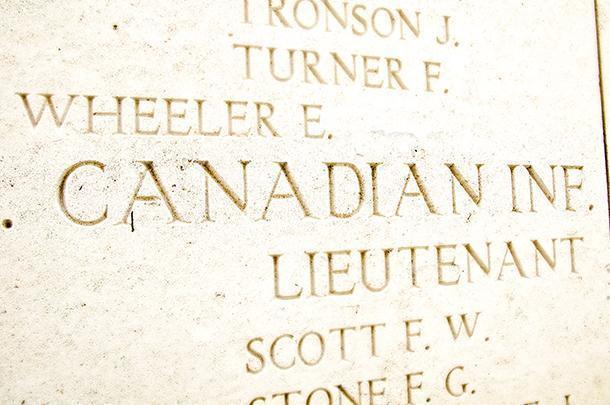
Menin Gate, Ypres, lists all of the names of soldiers with no known grave
If you are in Ypres, you must attend the Last Post ceremony at Menin Gate. Played every night at 8pm, since 1928, it is a moving ceremony, which brings me close to tears, every time I hear it. It is definitely worth hanging around Ypres to witness. In summer, and on November 11th, it can be crowded, so you may need to arrive early, to get a good spot.
5. Passchendaele Memorial (Belgium)
In late October, 1917, the Canadians were once again thrown against a formidable German position. After relieving a decimated Australian-New Zealand contingent, the Canadians were ordered to attack and capture the village of Passchendaele. Despite protests from the Canadian officer in charge, about the miserable conditions, the attack kicked off, on October 26th. It was met with stiff resistance and, by November 1st, had gained the outskirts of the village. The men held on valiantly and, by November 10th, pushed the Germans off part of the Passchendaele-Westrozebeke ridge.
The sacrifice of over 15,000 men, killed or wounded, was a huge loss for Canada and, today, a memorial stands where the Canadians faced some of the toughest resistance. The Passchendaele Memorial is set in a grove of maple trees, surrounding a block of Canadian granite, on a small ridge. From the memorial, an avenue of trees draws your eye to the spires of Ypres — not far off as the crow flies — demonstrating just how hard the soldiers had to fight for such small gains.
Also worth visiting is the Passchendaele Museum. The museum provides an excellent overview of the situation, previous battles, and also features a reconstruction of an underground bunker.
Canadian Memorials of the Second World War (1939-1945)
The Second World War was far more mobile than the First World War, meaning while Canadian soldiers fought in Hong Kong, Italy, and Northern Europe, our sailors were fighting on every ocean. Again, Canadians earned respect, as they slogged up the Italian coast, battled submarines in the North Atlantic, or fought for control of Antwerp’s estuary.
The following are five memorials, in Europe, significant to the Canadian involvement in the Second World War.
1. Juno Beach/Beny-sur-mer Cemetery

The Beny-sur-mer Cemetery, near Juno Beach, in Normandy
If Vimy is Canada’s most important First World War memorial, Juno Beach is arguably Canada’s most important Second World War memorial. On June 6th, 1944, Canadian troops stormed ashore, between Courseulles-sur-Mer and Saint-Aubin-sur-Mer, in Normandy, France. Although the Canadians fell short of their objectives for the day, they still made some of the most substantial gains, against the Germans, of all the Allies. Outside of Caen, they ran into stiff resistance, which took another month to overcome.
The Juno Beach Centre, in Courseulles-sur-Mer, sits where Canadian troops fought their way ashore on D-Day. Obviously, the centre talks about the landings, but it also serves to educate visitors about Canada’s wider role in the war. As an introduction to Canada’s Second World War involvement, there is no better place to start. It is also worth a walk on the beaches, to understand just how formidable it was to charge across that beach under fire.
2. Square du Canada, Dieppe (France)
Two years prior to the 1944 invasion of France, Canadians were involved in a raid on Dieppe, ostensibly to test the German defences along the coastline. The British and Americans were under increasing pressure, from Russia, to open a western front. Eventually, in August 1942, they agreed on a plan to raid the French port of Dieppe. The Canadians were hungry to get involved, so they were put in the vanguard of the attack. It was an unmitigated disaster.

The D-Day landing becahes, along the coast of Normandy, France
Of 5000 Canadians who landed on the beach, 68% were killed, wounded, or taken prisoner. The only benefits to come from this raid were lessons learned on how not to assault a prepared coastal position; lessons that were used two years later, during the D-Day landings. Canadians would return to Dieppe and liberate the town, on Sept 1, 1944.

Memorials along the beaches of Dieppe are reminders of Canada’s sacrifice here
The Canadian memorial, in Dieppe, is in a small park, at the western end of the beach, called Square du Canada (Canada Square). Although the park contains a small monument and a plaque, dedicated to the soldiers who died in the raid, the real reason to visit is to stand on the beach and wonder at the folly of attacking this exposed stretch of coastline. The town has also set up a number of small memorials along the beach, which are a nice touch, to help visitors understand what happened.
3. Montormel Museum (France)
At the end of July, 1944, Caen, in Normandy, had fallen to the Canadians and British. To the west, the Americans had broken through the German line and were marauding deep into western France, heading towards Paris. The Germans were being encircled by the Allies, a situation the Germans made worse, by attempting to counterattack the Americans.
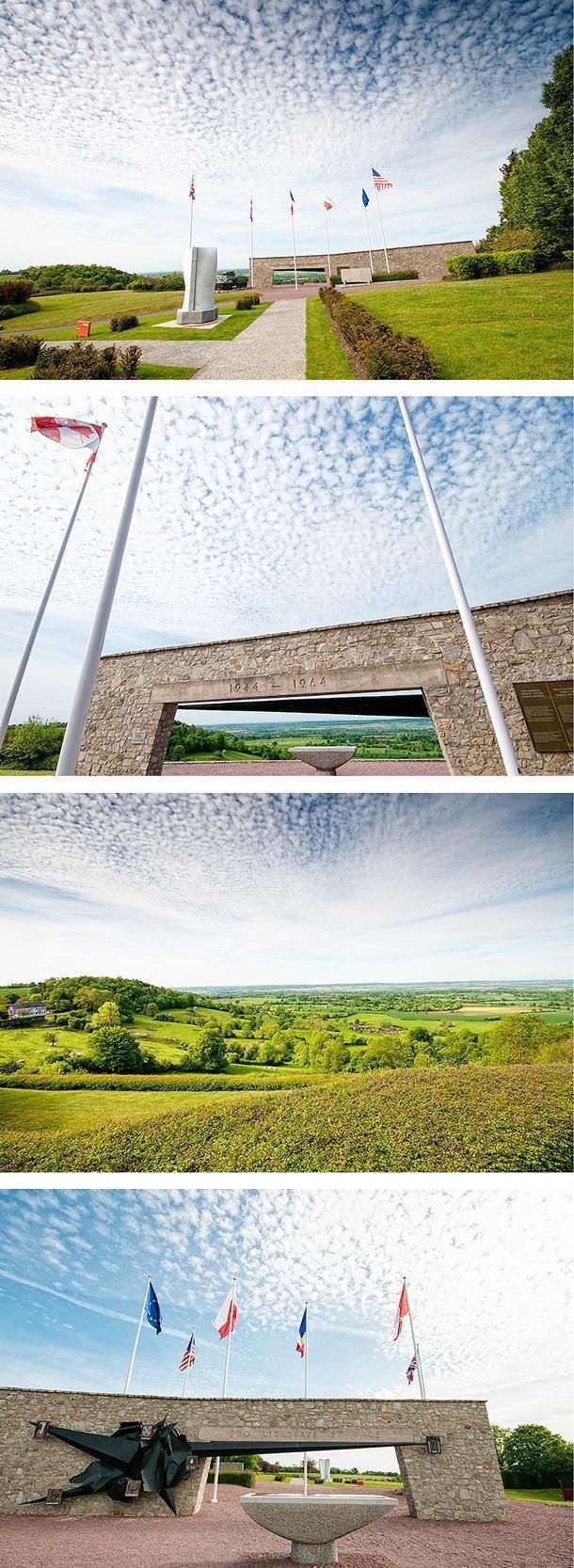
The Mont-Ormel Museum, in Normandy, France
Identifying an opportunity, Allied commander, Bernard Montgomery, ordered the Americans to push up from the south, while the Canadians and Polish Armoured Division closed the gap from the north. By the middle of August, the Allies had almost completely encircled the Germans. Only a narrow gap, between Falaise and Argentan, allowed the remaining Germans any hope of escape. After the Polish Armoured took a serious beating, on August 21st, the gap was sealed, trapping 50,000 Germans and effectively breaking the back of the German armed forces.
Although Mont-Ormel Museum is, deservedly, dedicated to the heroics of the Polish Armoured brigade, the Canadians also played a vital role in closing this gap, cooperating closely with the Polish. The Battle of the Falaise Gap was a turning point in the war and Canada played a pivotal role. To understand how this battle unfolded and its impact on the rest of the war, I highly recommend visiting the Montormel Museum.
4. Wageningen Liberation Day Parade (Netherlands)
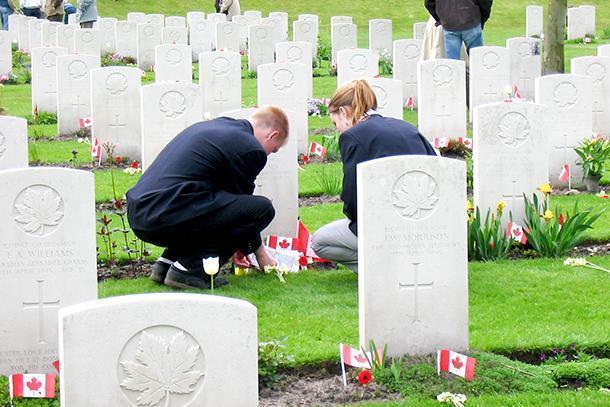
The cemetery in Holten on Liberation Day
One of our most surreal experiences was attending the Liberation Day ceremonies, in Holten and Wageningen, in the Netherlands. We visited in 2005, during the 60th Anniversary of the victory in Europe and the place was chock full of Canadiana. There were Canadian flags everywhere, signs in windows saying, “Thank you, boys!”, and red maple leaves painted on people’s faces. It was as if we were dropped in the middle of a chaotic Canada Day celebration, except we were in the heart of the Netherlands.
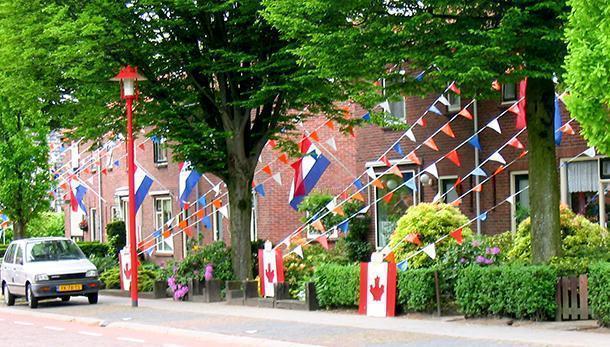
Proud to be a Canadian visiting Holten, the Netherlands
The back story is, on May 5th, 1945, after months of fighting, the Germans in the Netherlands surrendered to the Canadians, signing the armistice in Wageningen. Every year since, the citizens of the city and neighbouring towns put together a parade and commemoration of their liberation. It is a humbling and heartwarming event. Remembrance Day parades in Canada are often sombre but, here, the veterans are celebrated with vibrant colours and excitement. It is a remarkable contrast.
Nearby, the Holten Canadian War Cemetery is the final resting place of 1393 commonwealth soldiers, killed in the Netherlands and Germany. Set in a wooded area, the site, like all Commonwealth war cemeteries, is well looked after and is a beautiful spot to stop and reflect.
5. Cassino Memorial (Italy)
In 1943, the Allies invaded Italy, via Sicily. The battles in Italy are often overshadowed by the campaign in Northern Europe, but the fighting through the Italian mountains was some of the fiercest during the entire war. Cassino was the last German stronghold on what was called the Gustav Line. After the Polish pushed the Germans off Monte Cassino, the Canadians led an attack, on May 23rd, 1944, which broke through the lines and opened the path to Aquino and Rome.
The Cassino War Cemetery is overlooked by Monte Cassino and is home to 855 Canadians. The Cassino Memorial, in the cemetery, contains the names of 4000 Commonwealth soldiers, 192 of which are Canadian, who died in the Sicilian and Italian campaigns but for whom no known grave exists.
It is often hard to grasp the scale of the sacrifice, but these memorials and cemeteries provide a glimpse at the cost of war. Canadians made a difference, during the world wars, and we continue to make a difference in the world today. Our ability to have a say in world politics was earned through the blood and sacrifice of the men and women who fought on foreign soil.
As Canadians, we are taught to be modest, to consider other people’s feelings before our own, and to avoid being boastful. But beneath our polite veneer, we are proud of our heritage and the people who sacrificed their future so we could have our present. Just this once, let’s ignore our modesty and tell the world how proud we are of our men and women in uniform!
And now the Torch and Poppy Red
We wear in honor of our dead.
Fear not that ye have died for naught;
We’ll teach the lesson that ye wrought
In Flanders Fields.
– Moina Michael, We Shall Keep the Faith
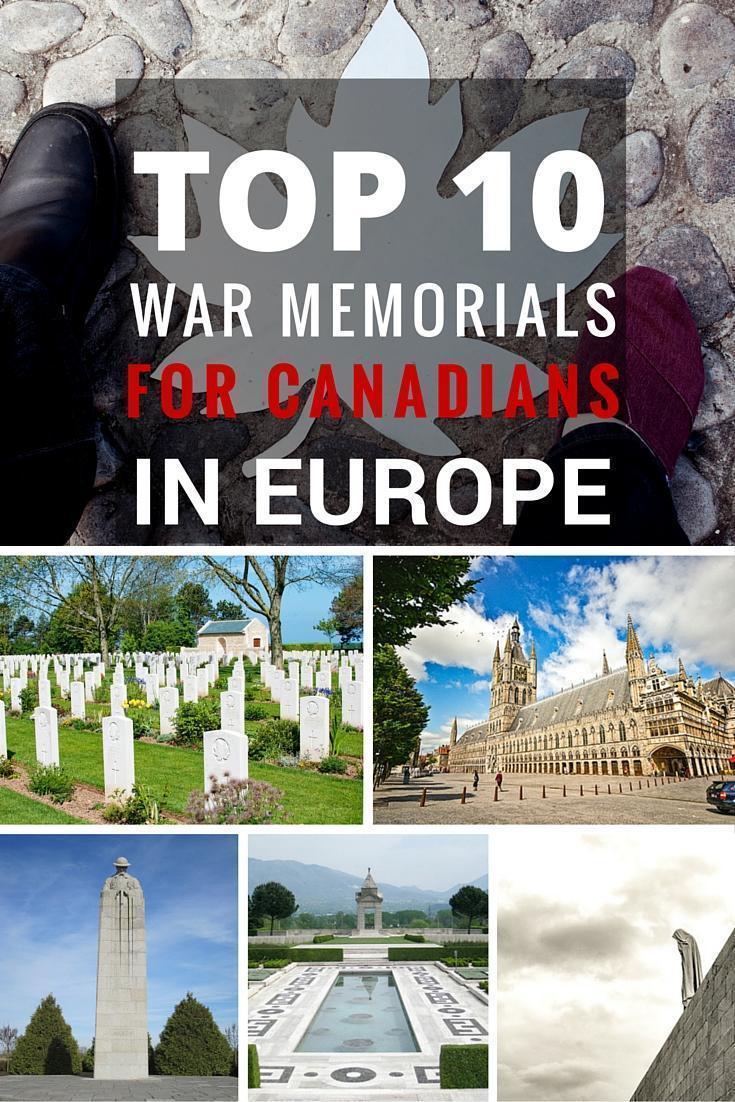
Like this pin? Save it to Pinterest!
- Wise Review: How to Save Money on International Currency Transfers - January 20, 2017
- Our 50+ Best Belgium Gifts Online - November 29, 2016
- Review: Crowne Plaza – Le Palace Hotel and Restaurant, Brussels, Belgium - September 30, 2016
- Visiting The Battlefields of Verdun, France
- Exploring the Battlefields of Ypres, Belgium
- Ypres World War One Museums
- Visiting the Fort de Loncin WWI Memorial Site, in Liege, Belgium
- Visiting the Atlantic Wall Museum, Oostende, Belgium
- Bastogne WW2 War Museum, Belgium
- Visiting the Bastogne Barracks and the Vehicle Restoration Centre, Wallonia, Belgium
- Visiting the Fort de Barchon in Liège, Belgium
- Visiting Fort Eben-Emael in Liège, Belgium
- Top 10 War Memorials for Canadians in Europe


